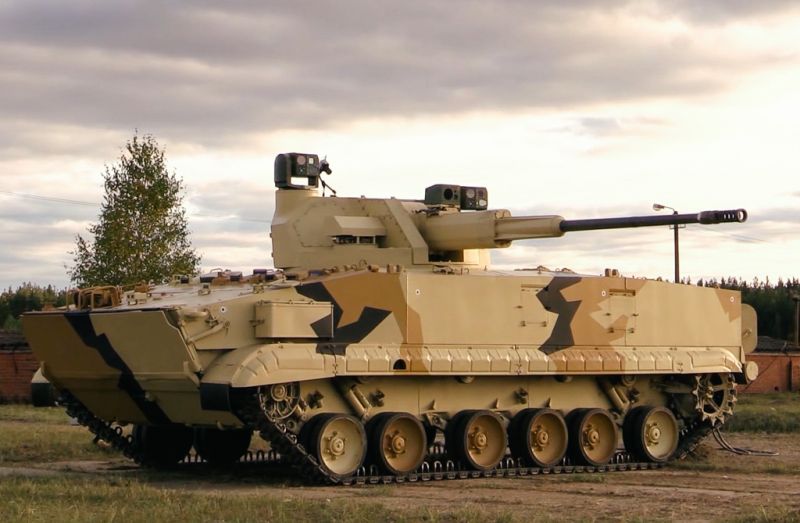DefExpo 2020 - Russia
Russia to present its latest weapons systems

AU-220M autocannon
The centrepiece of Russian display at the expo is its 57 mm autocannon designed for installation on all kinds of armoured vehicles. AU-220M is a remote-controlled, fully automatized unmanned artillery module. It can be used both as part of the combat vehicles and as a stationary system. There is also the naval version of the system.
The system is exhibited in India for the first time.
It is designed to follow the new trend of increasing the calibre of the automatic artillery systems. It is composed of two guns – 57 mm cannon and 7.62 mm 6P7K machine-gun. The auto-cannon can fire various kinds of ammunition including fixed rounds with high-explosive,armour piercing and guided projectiles. The horizontal firing range is up to 14.5 km.
The fire control system (FCS) controls the operations of target detection and identification, gun laying and firing of the automatic gun and 7.62mm machine-gun when from a halt, on the move in any combat environment. The FCS is equipped with a sight unit, comprising a combined sight with thermal-imaging and TV channels, a laser-finder and independent dual-axis field of view stabilization.
The system has all-around armour protection against 7.62mm bullets and the front arc against 30mm shells.
Over the last one decades, world over militaries is looking at an automatic portable gun system which can be operated remotely. This gives operational flexibility in sub-conventional urban warfare and in conventional warfare.
Unlike other similar systems, the AU-220M uses heavier calibre autocannon system. Other systems use 30mm or 40mm cannons.
Russia intends to offer India the system for all its existing and future armoured and unmanned ground vehicles.
Russia offers layered anti-drone system
The world is witnessing Unmanned Aerial Systems (UAS) or drones as the emerging weapon of choice for state and non-state actors. The commercially available UAS can be weaponised with relative ease by non-state actors. The recent attack on Aramco refinery in Saudi Arabia by Yemen rebels was the wakeup call for militaries across the world. Militaries, on one hand, are acquiring UAS, on the other hand, wants systems to counter them. There is consensus among the experts that mid to large UAS can be easily intercepted by existing air defence systems. But those are ineffective against the mini drones of all kinds.
To this effect, Russia is offering a layered anti-drone system to counter small-sized UAS which could pose a threat to the vital installations.
The anti-drone system which can be installed on any vital installation includes radar, command and control, reconnaissance system, weapons, electronic warfare system specially designed for mini-UAS. All the components of the system are well integrated for real-time identification, location of the drones. The system uses radio-jamming (soft-kill) and weapons(hard-kill) to neutralise drones.
The system employs well known Russian short-range surface to air systems like Pantsir-S1, Tor-М2E (or autonomous combat modules of Tor-М2KМ) and other systems which may be integrated as per requirements.
The specially developed detection and radio-electronic suppression systems intended for use against the small size UAVs are Repellent, Sapsan-Bekas, Kupol-PRO, Pischchal-PRO, Arbalet, Luch etc.
The open architecture gives the system flexibility to integrate other systems as and when required.
Russian sources believe that this system has advantages as it employs various types of reconnaissance, interceptors, and radio/electronic kill systems where firepower is not cost-effective or employable. Russia has offered them to a number of countries, including India. According to a source, some of the anti-UAV electronic warfare systems could be showcased at DefExpo 2020.
Anti Drone Elecronic Warfare Systems:
Pischchal-PRO
Wearable system designed to disrupt the flight mission of unmanned aerial vehicles by suppressing communication channels, controlling and navigating drones to secure site. It can be used in both stationary and mobile situations.
Weight 3.5 kg
Anti-UAV suppression range up to 2000 m
Continuous operation up to 1 hr
Operating temperature range – -20 to 40 °С
Kupol-PRO
Designed to disrupt the UAS navigation system, Kupol is a portable system with 360 ° coverage area. Range up to 2500 m
Weight 13 kg
Deployment time 4-5 min
Operating temperature range – -40 to 50°С
Can be used under dust and sand conditions
Luch-PRO
It is a stationary anti-drone system designed to disrupt navigation, command and control channels of the drones.
Range up to 6000 m
Weight 25 kg
Operating temperature range - -40 - +50°С
Can be used under dust and sand conditions
Sapsan-Bekas:
It is a vehicle based mobile soft-kill anti-drone system.
The system has any UAS detection range of 10 km and can soft-kill any drone within the range of six kilometres. It uses radio suppression for soft kill. The Sapsan-Bekas consists of three subsystems for detection and direction finding, active radiolocation and video and optoelectronic tracking, as well as a radio suppression subsystem. Sapsan-Bekas is able to control airspace around the clock and recognize airborne objects using video and thermal imaging surveillance tools.




